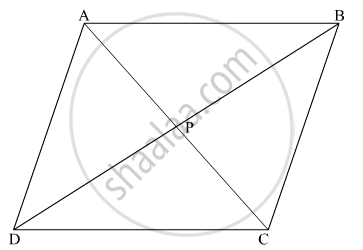Advertisements
Advertisements
Question
ABCD is a parallelogram and P is the point of intersection of its diagonals. If O is the origin of reference, show that
\[\vec{OA} + \vec{OB} + \vec{OC} + \vec{OD} = 4 \vec{OP}\]
Solution

Given a parallelogram ABCD and P is the point of intersection of its diagonals. We know the diagonals of a parallelogram, bisect each other. Therefore,
\[\frac{\vec{OA} + \vec{OC}}{2} = \vec{OP} \]
\[ \vec{OA} + \vec{OC} = 2 \vec{OP} . . . . . \left( 1 \right)\]
\[\text{ and }\frac{\vec{OB} + \vec{OD}}{2} = \vec{OP} \]
\[ \vec{OB} + \vec{OD} = 2 \vec{OP} . . . . . \left( 2 \right)\]
Adding (1) and (2), We get,
\[\vec{OA} + \vec{OB} + \vec{OC} + \vec{OD} = 4 \vec{OP}\]
APPEARS IN
RELATED QUESTIONS
Find the values of x and y so that the vectors `2hati + 3hatj and xhati + yhatj` are equal.
Find the scalar and vector components of the vector with initial point (2, 1) and terminal point (–5, 7).
Find the sum of the vectors `veca = hati -2hatj + hatk, vecb = -2hati + 4hatj + 5hatk and vecc = hati - 6hatj - 7hatk.`
In triangle ABC, which of the following is not true:

A girl walks 4 km towards west, then she walks 3 km in a direction 30° east of north and stops. Determine the girl’s displacement from her initial point of departure.
If `veca = hati +hatj + hatk, vecb = 2hati - hatj + 3hatk and vecc = hati - 2hatj + hatk` find a unit vector parallel to the vector `2veca - vecb + 3vecc`.
Let `veca = hati + 4hatj + 2hatk, vecb = 3hati - 2hatj + 7hatk ` and `vecc = 2hati - hatj + 4hatk`. Find a vector `vecd` which is perpendicular to both `veca` and `vecb`, and `vecc.vecd = 15`.
ABCD is a quadrilateral. Find the sum the vectors \[\overrightarrow{BA} , \overrightarrow{BC} , \overrightarrow{CD}\] and \[\overrightarrow{DA}\]
ABCDE is a pentagon, prove that
\[\overrightarrow{AB} + \overrightarrow{BC} + \overrightarrow{CD} + \overrightarrow{DE} + \overrightarrow{EA} = \overrightarrow{0}\]
ABCDE is a pentagon, prove that
\[\overrightarrow{AB} + \overrightarrow{AE} + \overrightarrow{BC} + \overrightarrow{DC} + \overrightarrow{ED} + \overrightarrow{AC} = 3\overrightarrow{AC}\]
If P is a point and ABCD is a quadrilateral and \[\overrightarrow{AP} + \overrightarrow{PB} + \overrightarrow{PD} = \overrightarrow{PC}\], show that ABCD is a parallelogram.
ABCD are four points in a plane and Q is the point of intersection of the lines joining the mid-points of AB and CD; BC and AD. Show that\[\vec{PA} + \vec{PB} + \vec{PC} + \vec{PD} = 4 \vec{PQ}\], where P is any point.
Prove that the points \[\hat{i} - \hat{j} , 4 \hat{i} + 3 \hat{j} + \hat{k} \text{ and }2 \hat{i} - 4 \hat{j} + 5 \hat{k}\] are the vertices of a right-angled triangle.
Write \[\overrightarrow{PQ} + \overrightarrow{RP} + \overrightarrow{QR}\] in the simplified form.
Find the sum of the following vectors: \[\overrightarrow{a} = \hat{i} - 2 \hat{j} , \overrightarrow{b} = 2 \hat{i} - 3 \hat{j} , \overrightarrow{c} = 2 \hat{i} + 3 \hat{k} .\]
Find the unit vector in the direction of the sum of the vectors `2hati + 3hatj - hatk and 4hati - 3hatj + 2hatk .`
Show that the sum of three vectors determined by the medians of a triangle directed from the vertices is zero.
If `6hati + 10hatj + 3hatk = x(hati + 3hatj + 5hatk) + y(hati - hatj + 5hatk) + z(hati + 3hatj - 4hatk)`, then ______
`[(bar"a", bar"b" + bar"c", bar"a" + bar"b" + bar"c")]` = ______.
Find the value of λ such that the vectors `vec"a" = 2hat"i" + lambdahat"j" + hat"k"` and `vec"b" = hat"i" + 2hat"j" + 3hat"k"` are orthogonal ______.
Let the position vectors of the points A, Band C be `veca, vecb` and `vecc` respectively. Let Q be the point of intersection of the medians of the triangle ΔABC. Then `vec(QA) + vec(QB) + vec(QC)` =
`veca, vecb` and `vecc` are perpendicular to `vecb + vecc, vecc + veca` and `veca + vecb` respectively and if `|veca + vecb|` = 6, `|vecb + vecc|` = 8 and `|vecc + veca|` = 10, then `|veca + vecb + vecc|` is equal to
A vector whose initial and terminal point continues is known as:-
If in ΔABC, `vec(BA) = 2veca` and `vec(BC) = 3vecb`, then `vec(AC)` is ______.
